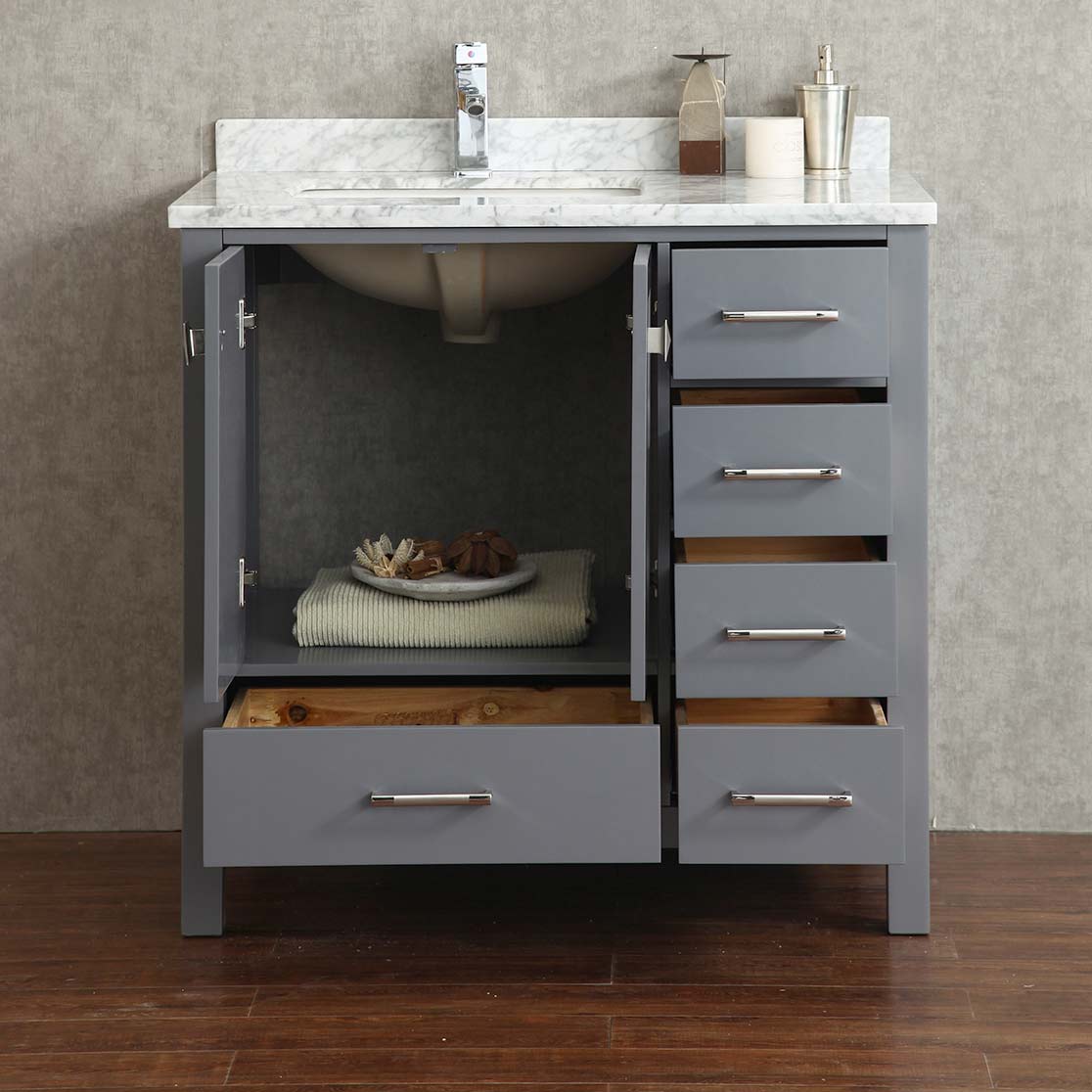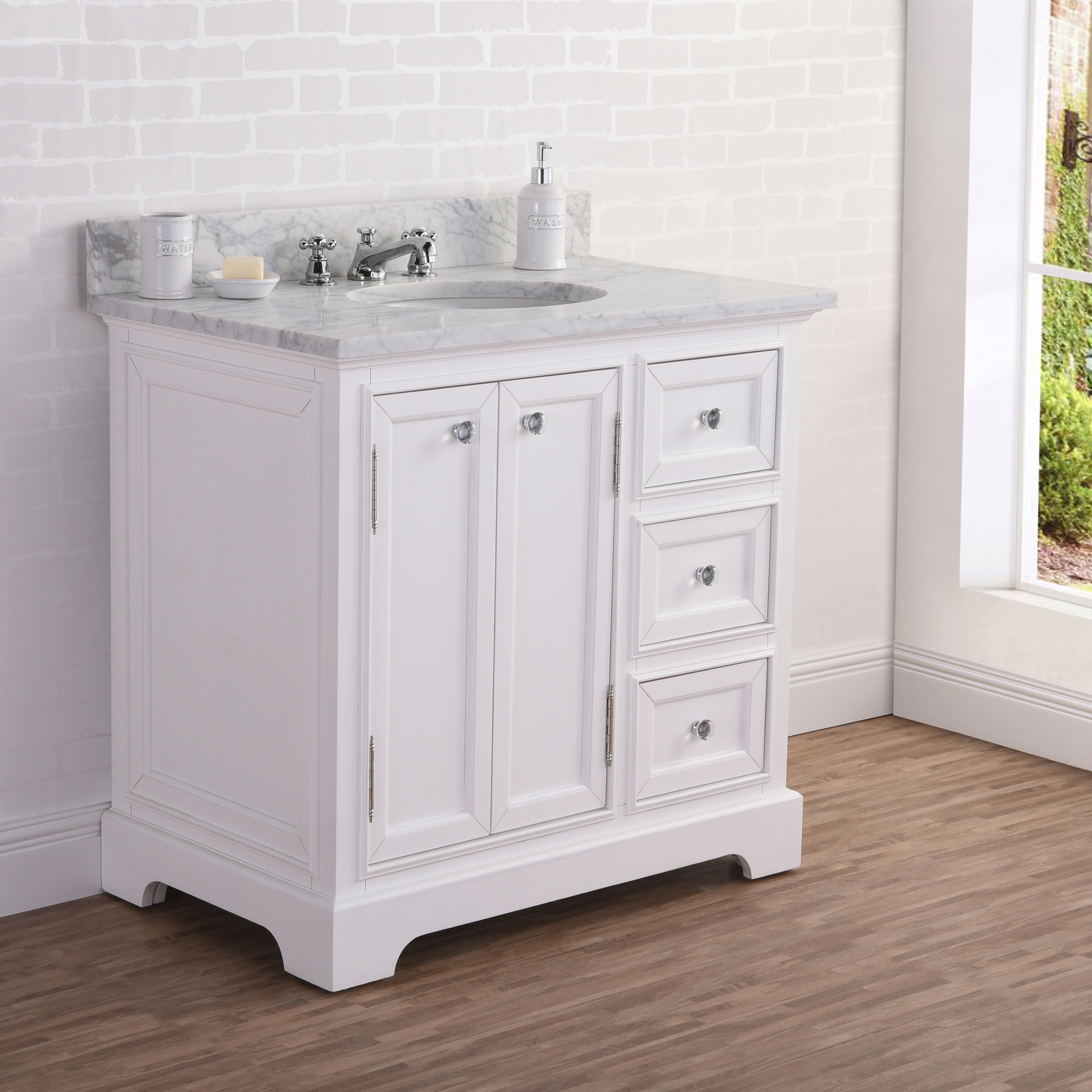Understanding 36 Inch Bathroom Vanities Without Tops: 36 In Bathroom Vanity Without Top

A 36-inch bathroom vanity without a top is a base cabinet designed to hold a sink and other bathroom essentials, but it does not come with a countertop or sink. This provides a unique opportunity to customize your bathroom design by choosing the perfect countertop and sink to complement your style and needs.
Choosing a vanity without a top offers several advantages. Firstly, it allows for greater flexibility in selecting the countertop and sink that best suits your preferences and budget. You can opt for a high-end, durable material like quartz or granite or choose a more affordable option like laminate or cultured marble. Secondly, a vanity without a top gives you more control over the overall design of your bathroom. You can choose a countertop that complements the style of your vanity, your bathroom fixtures, and your overall decor.
Materials Used for 36-Inch Vanities
36-inch bathroom vanities are typically constructed from a variety of materials, each offering its own advantages in terms of durability, aesthetics, and cost.
- Wood: Wood is a popular choice for bathroom vanities due to its natural beauty and versatility. Common wood types include oak, maple, cherry, and walnut. These woods can be stained or painted to match your bathroom’s décor.
- Engineered Wood: Engineered wood, such as plywood and medium-density fiberboard (MDF), offers a more affordable alternative to solid wood. These materials are also generally more stable and less prone to warping or cracking.
- Laminate: Laminate is a durable and cost-effective option that mimics the look of natural stone or wood. It is available in a wide variety of colors and patterns.
- Metal: Metal vanities, often made from stainless steel or aluminum, are known for their durability and modern aesthetic. They are typically more expensive than wood or laminate vanities.
Common Styles and Designs
36-inch bathroom vanities without tops are available in a wide array of styles and designs to suit various tastes and bathroom aesthetics.
- Traditional: Traditional vanities often feature ornate details, such as carved legs, raised panels, and intricate hardware. They are typically made from solid wood and have a timeless appeal.
- Modern: Modern vanities are characterized by clean lines, minimalist designs, and sleek finishes. They are often made from materials like stainless steel, glass, or high-gloss laminate.
- Contemporary: Contemporary vanities share some similarities with modern vanities but often incorporate more natural elements, such as wood or stone. They typically have a more organic and earthy feel.
- Rustic: Rustic vanities have a casual and relaxed vibe. They are often made from reclaimed wood or materials with a distressed finish.
Choosing the Right 36 Inch Vanity

A 36-inch vanity can be a perfect fit for a smaller bathroom, offering ample storage and a stylish look. However, with so many options available, choosing the right vanity can feel overwhelming. To help you navigate this process, let’s delve into some key considerations.
Vanity Features
Understanding the different features of 36-inch vanities will help you make an informed decision. Here’s a comparison table outlining common vanity features:
| Feature | Description |
|————–|————————————————————————————————————————————————————————————————————————————————————————————————————————————————————————————–|
| Material |
- Wood: Offers durability, classic elegance, and a wide range of finishes. Popular choices include oak, maple, cherry, and walnut.
- Laminate: Durable and affordable, offering various colors and patterns. It’s less prone to scratches and water damage compared to wood.
- MDF (Medium-Density Fiberboard): Affordable and versatile, but less durable than wood. It’s often used for contemporary vanities.
- Acrylic: Lightweight, easy to clean, and resistant to moisture. Offers a modern aesthetic.
|
| Style |
- Traditional: Features intricate carvings, ornate hardware, and classic design elements. Often made from solid wood with a rich finish.
- Modern: Clean lines, minimalist design, and sleek hardware. Often made from materials like acrylic or MDF.
- Transitional: Blends traditional and modern elements, creating a balanced and timeless aesthetic.
- Rustic: Uses reclaimed wood, natural finishes, and distressed hardware. Creates a warm and inviting ambiance.
|
| Storage Options |
- Drawers: Offer convenient storage for toiletries, towels, and other bathroom essentials.
- Cabinets: Provide ample space for larger items like hair dryers and styling tools.
- Open Shelving: Offers easy access to frequently used items and adds visual interest.
- Combination: A mix of drawers, cabinets, and open shelving provides versatile storage options.
|
Countertop Materials, 36 in bathroom vanity without top
The countertop is a crucial part of your vanity, impacting both its functionality and aesthetic. Consider these pros and cons of different countertop materials:
| Material | Pros | Cons |
|————–|————————————————————————————————————————————————————————————————————————————————————————————————————————————————————————————————————————————————————————————————————————————-|————————————————————————————————————————————————————————————————————————————————————————————————————————————————————————————————————————————————————————————————————————–|
| Granite |
- Durable and scratch-resistant
- Heat-resistant
- Unique patterns and colors
- High resale value
|
- Expensive
- Requires sealing to prevent staining
- Can be porous and absorb liquids
- Heavy
|
| Quartz |
- Durable and scratch-resistant
- Non-porous and stain-resistant
- Wide range of colors and patterns
- Easy to maintain
|
- Expensive
- Can be susceptible to heat damage
- Can appear artificial in some cases
|
| Marble |
- Elegant and timeless
- Unique veining patterns
- Cool to the touch
|
- Expensive and fragile
- Prone to scratches and stains
- Requires regular sealing
- Can be cold to the touch
|
| Laminate |
- Affordable and durable
- Wide range of colors and patterns
- Easy to clean
|
- Not as luxurious as natural stone
- Can be susceptible to heat damage
- Not as scratch-resistant as natural stone
|
| Solid Surface |
- Seamless and easy to clean
- Durable and scratch-resistant
- Available in a wide range of colors
|
- Can be expensive
- Can be susceptible to heat damage
- May not be as durable as natural stone
|
Sink Size and Style
The sink is an essential part of your vanity, and its size and style should complement the overall design.
A larger sink will provide more space for washing hands and faces, while a smaller sink may be better suited for a tight space.
Consider the following:
* Undermount Sink: This type of sink sits below the countertop, creating a seamless and elegant look. It’s a popular choice for modern bathrooms.
* Top-Mount Sink: This type of sink sits on top of the countertop, offering a more traditional aesthetic. It’s often easier to install than an undermount sink.
* Vessel Sink: This type of sink sits on top of the countertop and has a unique, decorative design. It can add a touch of elegance to your bathroom.
Choosing a Vanity for a Small Bathroom
When selecting a vanity for a small bathroom, space is paramount. Consider these tips:
* Opt for a smaller vanity: A 36-inch vanity is a good starting point for a small bathroom.
* Choose a vanity with vertical storage: Drawers and cabinets that extend upwards will maximize storage space.
* Consider a vanity with an open shelf: This will help to visually lighten the space.
* Choose a light-colored vanity: Light colors can make a small bathroom feel larger.
* Install a mirror with a shelf: This will provide additional storage and reflect light, making the space feel more spacious.
Installation and Customization

Installing a 36-inch bathroom vanity without a top is a straightforward process that can be done with basic tools and some patience. The customization options are vast, allowing you to create a vanity that perfectly suits your bathroom’s style and functionality.
Installing a 36-Inch Vanity Without a Top
The installation process begins with preparing the area where the vanity will be placed. This includes ensuring the floor is level and the wall is free of obstructions.
- Assemble the vanity base: Follow the manufacturer’s instructions for assembling the vanity base. This usually involves attaching the sides, back, and bottom panels.
- Position the vanity base: Carefully place the assembled vanity base in the desired location. Use a level to ensure it is perfectly level in all directions.
- Secure the vanity base: Use appropriate fasteners, such as screws or anchors, to attach the vanity base to the wall. The number and type of fasteners will depend on the vanity’s weight and the wall’s construction.
- Install the plumbing: Connect the vanity’s drain pipe to the bathroom’s main drain line. If the vanity has a sink, connect the water supply lines to the faucet.
- Attach the countertop: Once the vanity base is securely installed, you can attach the countertop. The method for attaching the countertop will vary depending on the countertop material and the vanity’s design. Common methods include using adhesive, clamps, or a combination of both.
Attaching a Countertop to the Vanity Base
The method for attaching a countertop to the vanity base depends on the countertop material and the vanity’s design.
- Adhesive: For solid surface countertops like Corian or granite, a strong adhesive is typically used. The adhesive is applied to the underside of the countertop and the top of the vanity base. The countertop is then carefully placed on the vanity base and allowed to cure according to the adhesive manufacturer’s instructions.
- Clamps: For some countertop materials, such as laminate or engineered stone, clamps may be used to hold the countertop in place while the adhesive dries. Clamps are placed around the perimeter of the countertop and tightened until the countertop is securely attached to the vanity base.
- Combination: Some countertop installation methods involve a combination of adhesive and clamps. For example, adhesive may be used to secure the countertop to the vanity base, while clamps are used to hold the countertop in place until the adhesive dries.
Customization Options
Customization options allow you to create a vanity that perfectly matches your bathroom’s style and functionality.
- Hardware: Hardware, such as knobs, pulls, and hinges, can be used to add a touch of personality to your vanity. Choose hardware that complements the style of your bathroom and the countertop.
- Painting: Painting the vanity base is a simple way to give it a new look. Choose a paint color that complements the rest of your bathroom decor.
- Lighting: Adding lighting to the vanity can improve its functionality and create a more inviting atmosphere. Consider using sconces, under-cabinet lights, or a combination of both.
Integrating a 36-Inch Vanity into Different Bathroom Layouts
A 36-inch vanity can be integrated into various bathroom layouts.
- Small Bathrooms: A 36-inch vanity is an excellent choice for small bathrooms, as it provides ample storage without taking up too much space.
- Large Bathrooms: In larger bathrooms, a 36-inch vanity can be used as a secondary vanity or placed in a guest bathroom.
- Corner Bathrooms: A 36-inch vanity can be placed in a corner to maximize space in a small bathroom.
36 in bathroom vanity without top – A 36-inch bathroom vanity without a top gives you a blank canvas to work with, letting you choose the perfect countertop and sink to fit your style. But if you’re short on space, maybe a smaller vanity like a 24 x 16 bathroom vanity is a better fit.
Either way, a vanity without a top lets you get creative and personalize your bathroom.
A 36-inch bathroom vanity without a top is a great option for a smaller space, and you can really personalize it with your own countertop. To tie in the whole look, consider adding some tier bathroom window curtains for a touch of elegance.
They’ll add a sense of privacy and give your bathroom a more sophisticated vibe, and they’ll complement the vanity perfectly.
